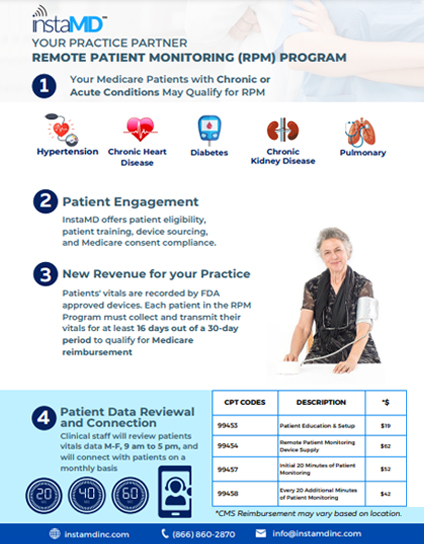Remote Patient Monitoring (RPM)
Remote Patient Monitoring (RPM) represents the next generation of healthcare, allowing patients and physicians to be connected like never before.


Leap Into Tomorrow with Remote Patient Monitoring (RPM)
RPM signifies a game-changing shift in healthcare, forging an unparalleled connection between patients and physicians. With the support of a broad spectrum of medical devices and extensive onboarding education, patients with chronic conditions can seamlessly share vital health data with their physicians for meticulous diagnosis.
This is where InstaMD shines. We provide an all-inclusive RPM service, teaming up with small to medium-sized practices to deliver:
- Swift onboarding services for patients, encompassing patient eligibility, insurance verification, patient education, and device logistics.
- User-friendly and familiar devices, ensuring zero technological barriers.
- Regular scrutiny of crucial health data.
- Prompt escalation of patient readings, bringing urgent health issues directly to the doctor's attention for immediate diagnosis.
- We also take care of ongoing program and patient unenrollment, as well as device return processing.
- Consider InstaMD as your steadfast remote medical support, fluent in multiple languages, and perpetually poised to enhance your patients' care using cutting-edge RPM technology and support."
Think of InstaMD as a reliable remote doctor’s assistant, bilingual and available for the enhanced care of your patients through RPM technology and support.
Program & Benefits
InstaMD’s patient-empowering and doctor-friendly Remote Patient Monitoring (RPM) program is comprehensive and focuses on 3 main services:
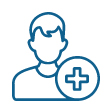
Patient Enrollment (Outreach + Education)

SmartHub and Cellular Integrated Medical Devices
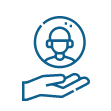
Full-Service Support with Data Review & Critical Escalations to Physician
RPM is for Medicare-qualified with chronic conditions

Your Medicare Patients with Chronic or Acute Conditions May Qualify for RPM
- Hypertension
- Chronic Kidney Disease
- Diabetes
- Heart Disease
- Lung Disease

Generate RPM Revenue for your Practice
Patients' vitals are recorded by FDA approved devices. Each patient in the RPM Program must collect and transmit their vitals for at least 16 days out of a 30-day period to qualify for Medicare reimbursement

Additional Potential Revenue for Patient Data Reviewal and Connection
Clinical staff will review patients vitals data M-F, 9 am to 5 pm, and will connect with patients on a monthly basis
InstaMD’s RPM program empowers Medicare patients with the technology and routine to keep up with their own health readings.
InstaMD’s RPM program provides doctors with better periodic information on their participating patients and allows for more timely interventions when needed.

In sum, InstaMD’s RPM program is comprehensive:
- Hassle-Free Patient Onboarding
- Easy Patient Access to Remote Health Monitoring Devices
- $0 Up Front Cost due to Medicare Program
- New Medicare-based Revenue Streams with Minimal Extra Labor from Your Practice
- Full-Service Support Team for All Your Remote Monitoring Telehealth Needs
Reimbursement
Due to a Medicare program incentivizing the implementation of RPM programs in doctor’s offices nationwide, your practice stands to gain new revenue streams from every qualified patient’s participation.
Kickstart Your RPM Program with InstaMD at Zero Upfront Cost
InstaMD's business model is designed to enable numerous practices to initiate their RPM program without any initial financial outlay. Our expert team ensures a smooth, hassle-free launch of your program - paving the way for you to start earning reimbursements while maintaining a better watch over your patients' health readings from a distance.
Medicare reimbursements hinge on your enrolled patients providing crucial health readings for at least 16 days within a 30-day cycle. Our team excels in educating patients, facilitating their onboarding, and ensuring their adherence to this policy.
With patient compliance and regular readings provided, your practice can anticipate stable cash flows of approximately $150 per patient each month!
Embracing InstaMD's RPM program equates to unlocking new avenues of potential reimbursement revenue for your practice, almost instantly."
Clients
InstaMD’s Remote Patient Monitoring (RPM) program is built to be implemented at all kinds of healthcare operations and medical offices. For any practice caring for Medicare patients suffering from chronic conditions, RPM’s enhanced vital readings and increased cash flows are available - with InstaMD’s help.
InstaMD’s client practices:

Small to medium-sized medical offices

Assisted-living facilities

Long-term care facilities

Telemedicine providers

Home healthcare

House call providers

Nephrology Network

Health Plans

IPA
We work with physicians and healthcare providers around the nation to launch and support RPM programs for their patients with conditions such as hypertension, heart disease, diabetes and more.

Hypertension

Chronic Kidney Disease

Diabetes

Heart Disease

Lung Disease
InstaMD’s RPM model is a win-win. Through transparent education and our proprietary SmartHub technology, we empower patients with a more satisfying medical device experience. Keeping up with vital health readings becomes more engaging for patients - and doctors stand to gain better information for the care of those patients.
RPM Benefits

Physician
- Improved Patient Management: RPM provides physicians with real-time patient data, which can be crucial in making timely and informed clinical decisions. This can lead to better patient outcomes, particularly for those with chronic conditions that need regular monitoring.
- Reduced Hospitalizations: Early detection of potential health issues through RPM can reduce the need for hospitalizations and readmissions, thereby improving patient outcomes and reducing healthcare costs.
- Expanded Care Coverage: RPM allows physicians to extend their services beyond their physical location, reaching patients who may live in remote areas or have mobility issues that make regular in-person visits challenging.
- Better Work-Life Balance: With RPM, physicians can monitor patient conditions from anywhere, providing some flexibility and potentially improving their work-life balance.
- Improved Reimbursement: With the shift towards value-based care and changes in reimbursement policies, physicians who utilize RPM can potentially see improved reimbursement rates. For instance, Medicare and some other payers have introduced separate reimbursement codes for RPM, recognizing its value in patient care.
- Continuity of Care: RPM can provide physicians with a more comprehensive view of their patients’ health over time, aiding in the delivery of consistent and coordinated care.
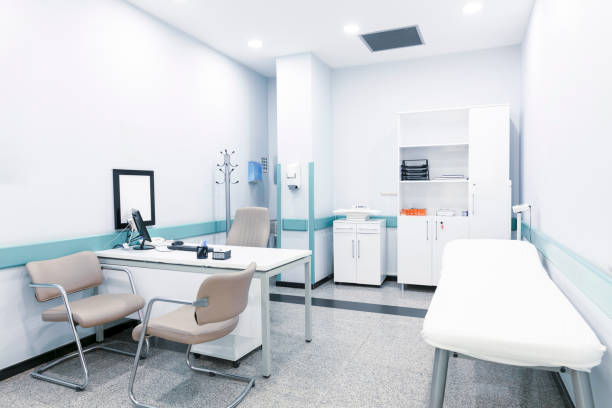
Medical Practice
- Improved Patient Outcomes: By allowing for real-time monitoring of patient health data, RPM can facilitate early detection of health issues and timely intervention, leading to better patient outcomes, particularly for those with chronic illnesses.
- Increased Efficiency and Productivity: RPM enables healthcare providers to monitor many patients simultaneously without the need for in-person visits. This leads to significant time savings and improved productivity, allowing medical practices to serve more patients and prioritize those who require immediate care.
- Enhanced Patient Engagement and Satisfaction: RPM encourages patients to take an active role in their healthcare, leading to increased patient engagement. The convenience of RPM can also increase patient satisfaction levels, as it reduces the need for travel and wait times associated with traditional office visits.
- Cost Savings: RPM can help reduce hospital admissions and readmissions by identifying health issues early before they become serious. This leads to significant cost savings for both the patient and the medical practice.
- Revenue Growth: With the shift towards value-based care, using RPM can lead to new revenue streams for medical practices. Several insurance providers, including Medicare, now provide reimbursement for RPM services.
- Expanded Access to Care: RPM allows medical practices to extend their reach beyond the confines of their physical location, offering services to patients in remote locations or those with mobility issues. This could potentially increase the patient base for the practice.
- Improved Data Collection: RPM provides a continuous stream of real-time patient data, which can be valuable for medical research and for tailoring personalized care plans.
- Better Care Coordination: By providing a continuous flow of patient data, RPM can aid in care coordination among various healthcare providers, leading to a more holistic approach to patient care.
- Reduced Overhead Costs: With fewer routine in-person visits, medical practices can reduce overhead costs related to facility usage, administrative tasks, and staffing needs.
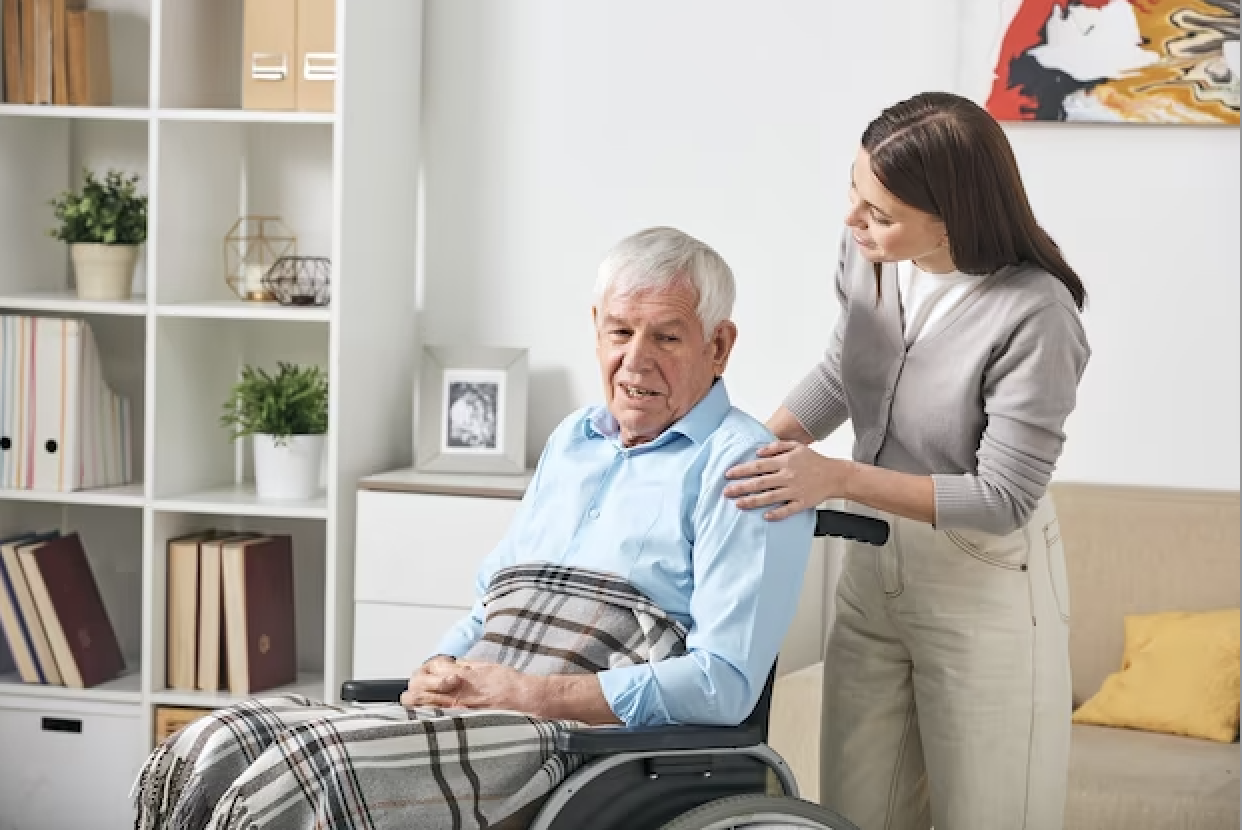
Facilities i.e., ALFs/SNFs and Dialysis Center
Remote Patient Monitoring (RPM) can provide significant advantages to Skilled Nursing Facilities (SNFs), Assisted Living Facilities (ALFs), and Dialysis Centers, such as:
- Enhanced Patient Care: With RPM, healthcare providers can continuously monitor patient vitals and health conditions, allowing for early detection of potential health issues and the ability to adjust care plans as needed.
- Reduced Hospital Admissions: RPM can help detect health issues before they become critical, potentially reducing the need for hospital admissions and readmissions. This is particularly important for patients in SNFs and ALFs who often have chronic conditions that require close monitoring.
- Improved Efficiency: RPM enables healthcare providers to monitor multiple patients simultaneously, saving time and resources. This can be particularly beneficial in SNFs, ALFs, and Dialysis Centers where staff resources may be limited.
- Support for Independent Living: For residents in ALFs, RPM can provide an additional level of support, allowing them to live more independently while ensuring their health is closely monitored.
- Better Management of Chronic Conditions: For Dialysis Centers, where patients typically have chronic conditions like kidney disease, RPM can provide continuous monitoring and data collection, helping to better manage these conditions and adjust treatment as necessary.
- Enhanced Communication: RPM provides real-time data that can be shared with the patient’s broader healthcare team, fostering better communication and collaboration among providers.
- Improved Patient Engagement: RPM can empower patients to take a more active role in their healthcare, leading to increased patient satisfaction and potentially better health outcomes.
- Compliance and Reporting: RPM can aid in the compliance with care standards and provide data for performance reporting.

Independent Physician Associations (IPAs)
Independent Physician Associations (IPAs) can greatly benefit from Remote Patient Monitoring (RPM) in the following ways:
- Improved Patient Management: RPM allows IPAs to proactively manage their patients, particularly those with chronic diseases, by monitoring their health status in real-time. This leads to improved health outcomes and greater patient satisfaction.
2. Risk Stratification: With real-time data from RPM, IPAs can stratify their patient population based on health risk and intervene timely for high-risk patients, thus preventing expensive hospital admissions or readmissions.
- Cost Efficiency: By enabling early detection of health complications and preventing unnecessary hospital admissions, RPM can significantly reduce healthcare costs. These savings can be passed on to both patients and healthcare providers.
- Enhanced Care Coordination: RPM provides continuous health data, allowing for better coordination of care among various healthcare providers within the IPA. This leads to a more holistic and efficient healthcare delivery.
- Value-Based Care: RPM can support IPAs in their transition from volume-based care to value-based care. By continuously monitoring patient health, IPAs can focus on keeping their patients healthy, reducing complications, and improving overall quality of care, which are all key aspects of value-based care models.
- Expanded Coverage: RPM allows IPAs to provide healthcare services to patients living in remote areas or who face difficulty in regular hospital visits, thereby increasing their reach and ensuring continuity of care.
- Patient Engagement: RPM gives patients more ownership over their healthcare. It encourages them to actively engage in their care, leading to improved adherence to care plans and better health outcomes.
- Compliance Reporting: RPM allows for easy tracking and reporting of compliance with quality measures and other contractual obligations, making it a valuable tool for IPAs participating in contracts with payers that include quality performance incentives.
- Post-Acute Care: RPM allows IPAs to better manage patients after they’re discharged from the hospital, reducing readmission rates and enhancing post-acute care outcomes.
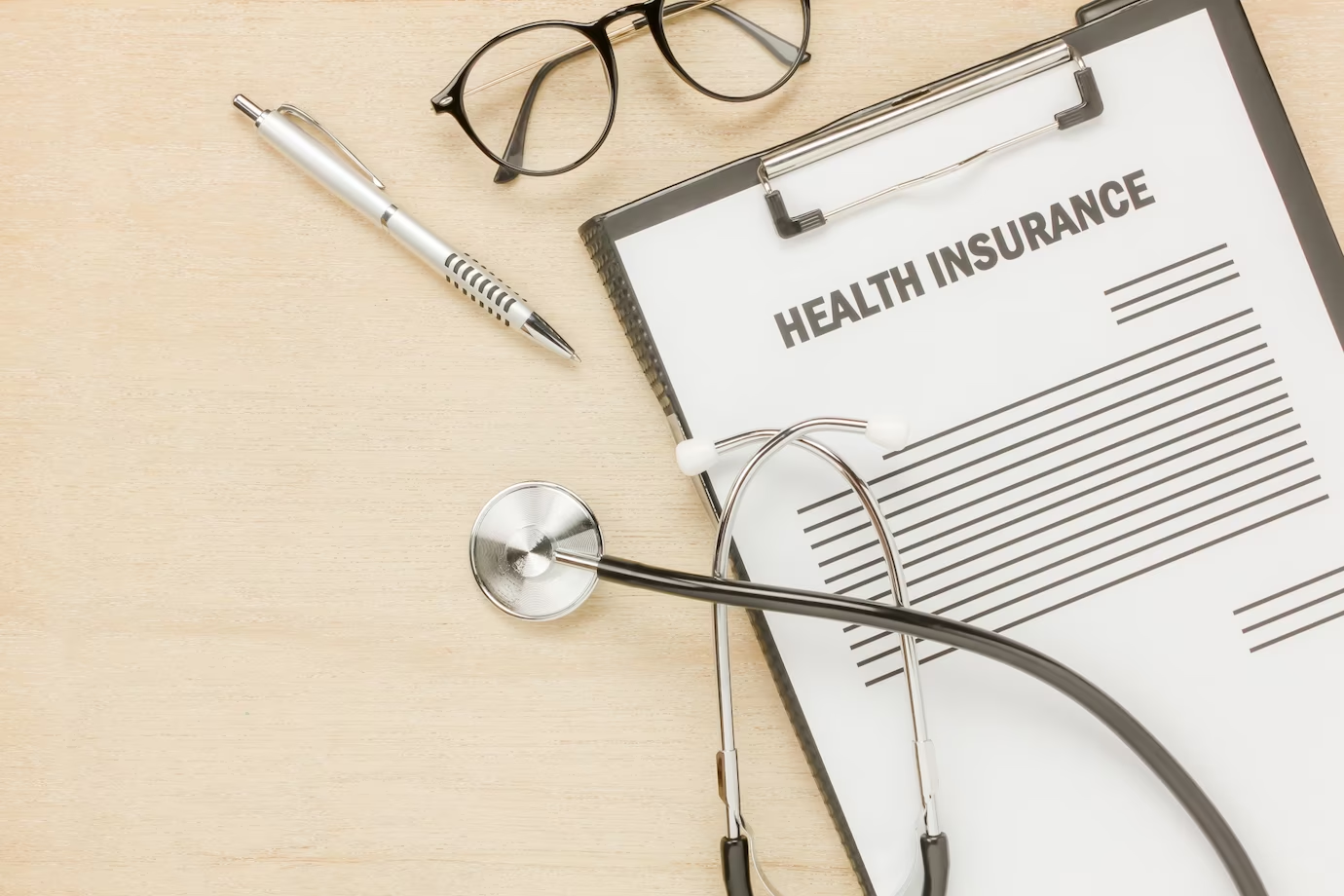
Medicare, Medicaid HMOs Health Plans
Medicare emote Patient Monitoring (RPM) can offer significant benefits to Medicaid and Medicare Health Maintenance Organizations (HMOs). These benefits include:
- Improved Quality of Care: RPM allows for real-time monitoring of patient health, which can lead to early detection of health problems and timely medical interventions, thereby enhancing the quality of care.
- Reduced Healthcare Costs: By enabling early intervention, RPM can prevent costly complications and unnecessary hospitalizations, thereby reducing overall healthcare costs. This is particularly beneficial for HMOs as they operate on a fixed prepaid budget per enrollee.
- Better Management of Chronic Conditions: RPM is particularly beneficial for managing chronic conditions like diabetes, heart disease, and COPD, which are common among Medicaid and Medicare beneficiaries. Continuous monitoring can help ensure that these conditions are managed effectively, preventing health deterioration and the need for emergency care Increased Access to Care: For beneficiaries living in remote areas or with mobility issues, RPM provides an opportunity to access consistent, quality healthcare without the need for regular physical visits to healthcare providers.
- Enhanced Patient Engagement: By providing patients with real-time data about their health, RPM encourages patients to take an active role in managing their health, which can lead to improved outcomes.
- Aid in Transition to Value-Based Care: RPM supports the shift towards value-based care, a key objective for many Medicaid and Medicare HMOs. By focusing on keeping beneficiaries healthy and improving the quality of care, HMOs can reduce costs and improve their performance under value-based payment models.
- Reduced Readmissions: For Medicare HMOs, in particular, reducing hospital readmission rates is crucial due to penalties associated with high readmission rates. RPM can aid in post-discharge monitoring, thereby reducing the risk of readmissions.
- Improved Data Collection and Reporting: RPM provides a wealth of real-time data that can be used for reporting purposes, performance tracking, and improving patient care strategies.
Our Devices
InstaMD provides a number of paths to connect patients and physicians through their medical devices.
We offer our premium SmartHub option, which adapts smartphone technology to seamlessly connect devices to a hub where you can view more information and conduct televisits with your physician at your convenience.
SmartHub Integrated Bluetooth FDA Devices:

Additionally, we provide a simpler but just as effective cellular ecosystem of medical devices which transmit to physicians via SIM card connection.
Cellular Connected FDA Devices:
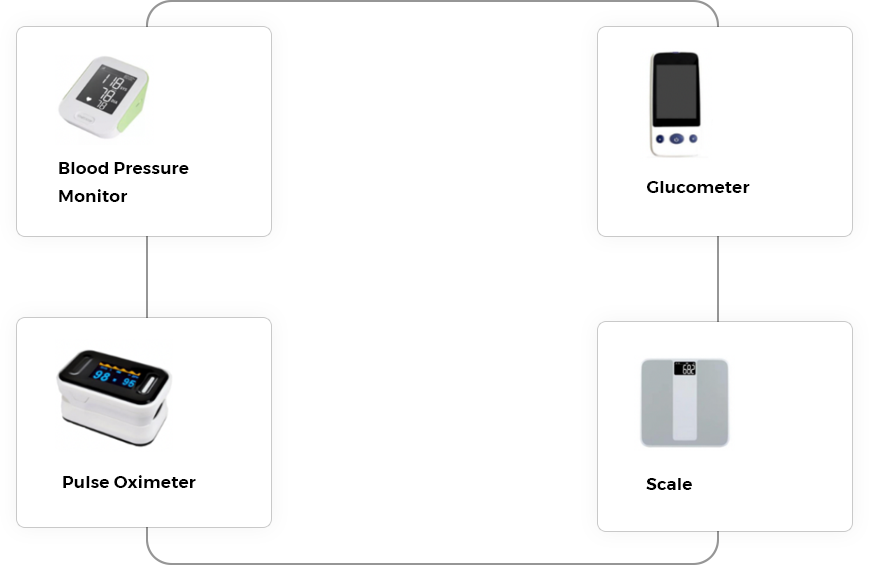
Both our proprietary SmartHub suite of technology and cellular-connected devices are provided to qualifying patients free of charge. You can also use your iPhone to connect to your physician via our InstaMD Patient App.
No matter the path you choose, with InstaMD patients and physicians are able to sync up to communicate vitals automatically and remotely. Easy to learn and use for patients of all ages, the InstaMD suite of devices means more efficient and effective RPM.
Platform
InstaMD’s platform is built from the ground up to be intuitive and easy to learn. First, we provide participating doctors and patients with interconnected medical devices. Then, our digital platform serves up automatic transmission of readings, televisit connectivity to the physician, critical notifications as needed, health analytics, and much more.
Together, our Device as a Service (DaaS) platform is here to make RPM as simply effective as possible.
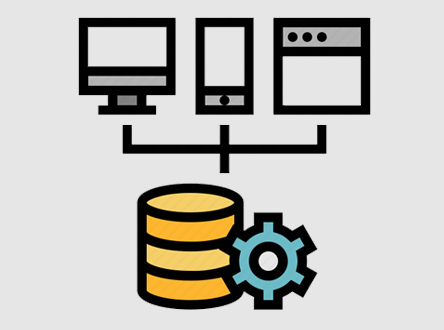

Our RPM Platform Benefits:
NOTIFICATIONS - The SmartHub devices or our Patient App can shoot Apple push notifications or SMS messages to patients and doctors to keep them informed on the readings.
WORKFLOWS - Our platform helps patients with everything from onboarding to data management and automated reminders, to televisit technology, clinical escalations, billings, and more.
INTEGRATIONS - Our platform automates claims submission and vitals data posting to over 94+ EHRs.
USER EXPERIENCE-FOCUSED - Most importantly, our devices and platform alike are simple to use and hassle-free to learn.
Platform Features
- Cellular Devices
- SmartHub & Bluetooth (BLE) Devices
- Management Portal
- Provider App
- Patient App (if needed)
- Real-time Multi-mode Notifications (SMS, Push)
Platform Technical Specifications
- HIPAA Complaint
- High Availability
- Scalable
- Pub/Sub
- Dedicated Tenant
- Data Encrypted at REST and Transit
- Meets Enterprise Security Standards
InstaMD RPM for Clinical Trial

InstaMD's Remote Patient Monitoring (RPM) technology is an innovative solution that has significant potential for clinical trials. By leveraging our RPM technology, we can provide a more efficient, cost-effective, and accurate way to monitor patients in clinical trials.
Our RPM technology enables remote collection and monitoring of patient data, which allows for real-time analysis and reporting of patient health status. This not only reduces the need for in-person visits but also improves the accuracy of data collection, which is critical for clinical trials.
With our platform, clinical trial coordinators can monitor patient health status remotely and receive alerts in real-time when patients require medical intervention. This helps to improve patient outcomes and reduce the likelihood of adverse events.
Furthermore, our platform allows for personalized treatment plans to be developed for each patient, which can improve adherence and ultimately lead to better outcomes. The flexibility of our platform means that it can be tailored to the unique needs of each clinical trial, ensuring the highest quality of patient care and data collection.
Overall, InstaMD's RPM technology has the potential to transform clinical trials by providing a more efficient, accurate, and cost-effective way to monitor patient health status. With our platform, clinical trial coordinators can improve patient outcomes, reduce the likelihood of adverse events, and ultimately deliver higher quality research data.
To learn more about our solution customized for clinical trial
InstaMD RTM Solution

The Medicare Remote Therapeutic Management (RTM) program is a new initiative aimed at improving the care and management of patients with chronic conditions. The program is designed to leverage the latest technology and medical expertise to provide patients with a more personalized and effective treatment plan.
Under the Medicare RTM program, healthcare providers will use remote monitoring technologies to track patients' health status, medication adherence, and other important health factors. Patients will be able to receive real-time feedback on their health status and get regular check-ins from healthcare providers, making it easier to manage their conditions from home.
The RTM program is aimed at improving outcomes for patients with chronic conditions and reducing healthcare costs associated with hospitalizations and other complications. By providing more frequent check-ins and feedback, the program can help prevent issues before they become more serious and require more intensive care.
The RTM program is available to Medicare beneficiaries who have two or more chronic conditions that require ongoing care. The program is covered by Medicare, making it an accessible and affordable option for patients who qualify.
Overall, the Medicare RTM program is a groundbreaking initiative that has the potential to transform the way we manage chronic conditions. By leveraging the latest technology and medical expertise, we can provide patients with a more personalized and effective treatment plan, improving their quality of life and reducing healthcare costs for all.
To learn more about our RTM solution
Platform Modules
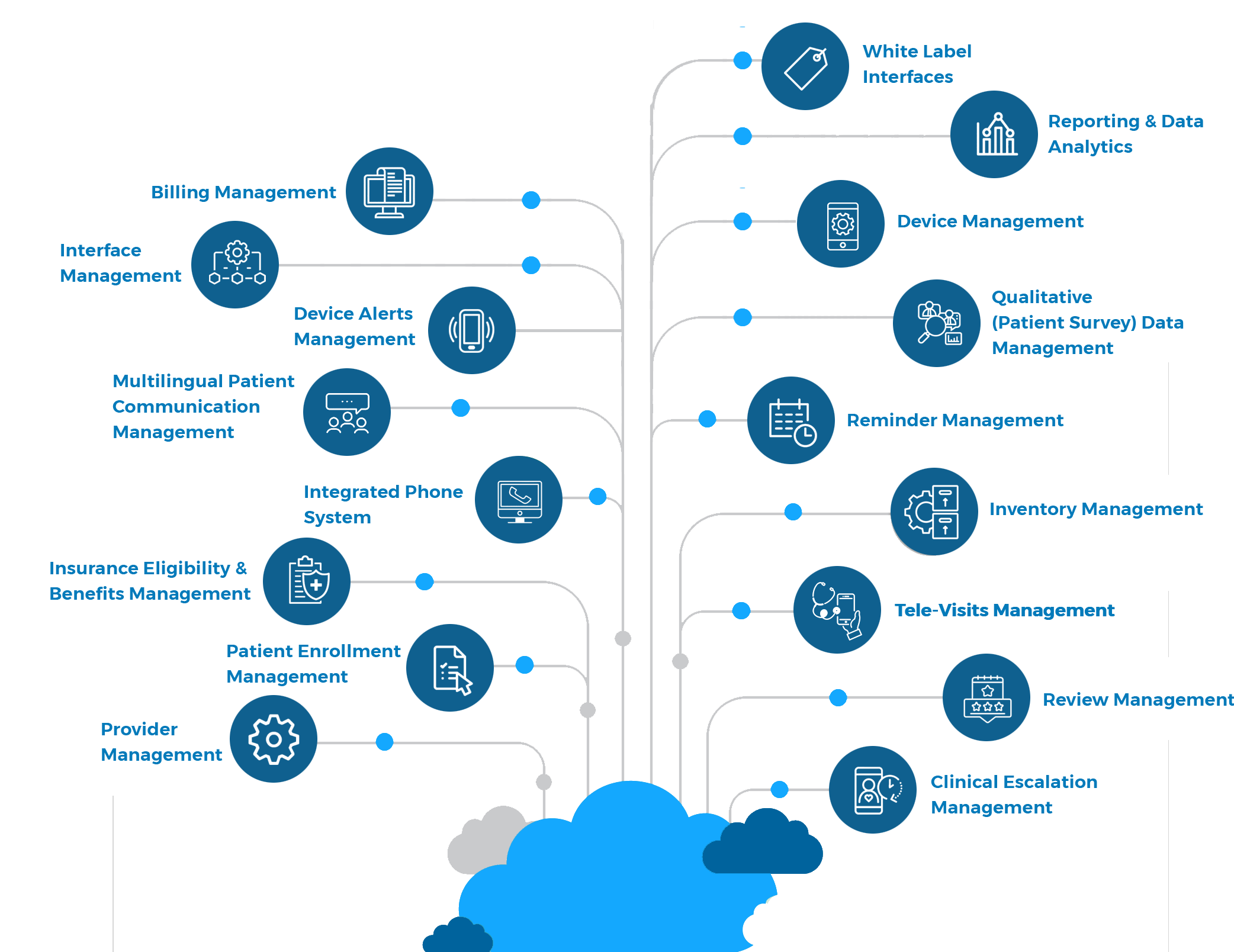
White Label Solution
For client medical practices with a high volume of patients in RPM, we can provide brandless white label devices upon request and at ZERO extra charge.
White labeling means our SmartHub suite of devices, packaging, associated instructions, digital portal, and more will all be free to use the custom branding requested by your medical practice.


InstaMD’s White Label Features:
- Management Portal with customer logo
- Client-branded Device Package
- Client-Specific Patient Instruction Content
- Client-branded Patient Flyer
- Client-branded Shipping Package
- Client-branded ordering site (Shopify)
- Patient & Physician Caller ID setup
- Customized Reporting/Analytics
- BYOD Supported
- Custom device integration
- Electronic Health Records (EHR) Integration
Get Started
If your practice is looking to implement RPM - or wishes to change providers - please contact us today. We’ll schedule a free demo and connect you with our team to discuss the details of getting your program underway at your practice for your patients.
InstaMD promises to introduce your practice and patients to the next generation of healthcare.

